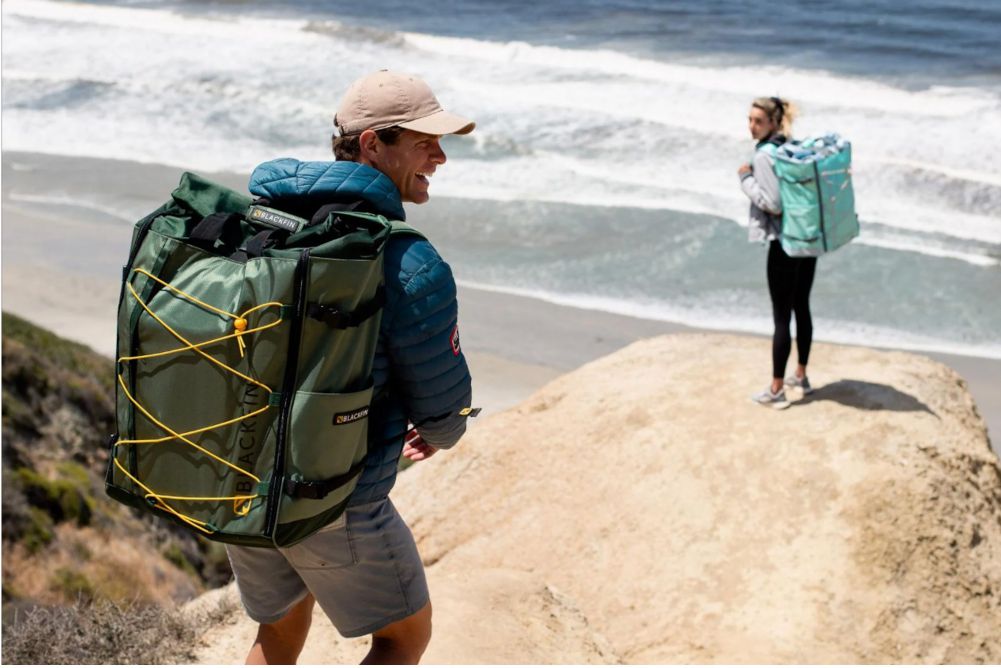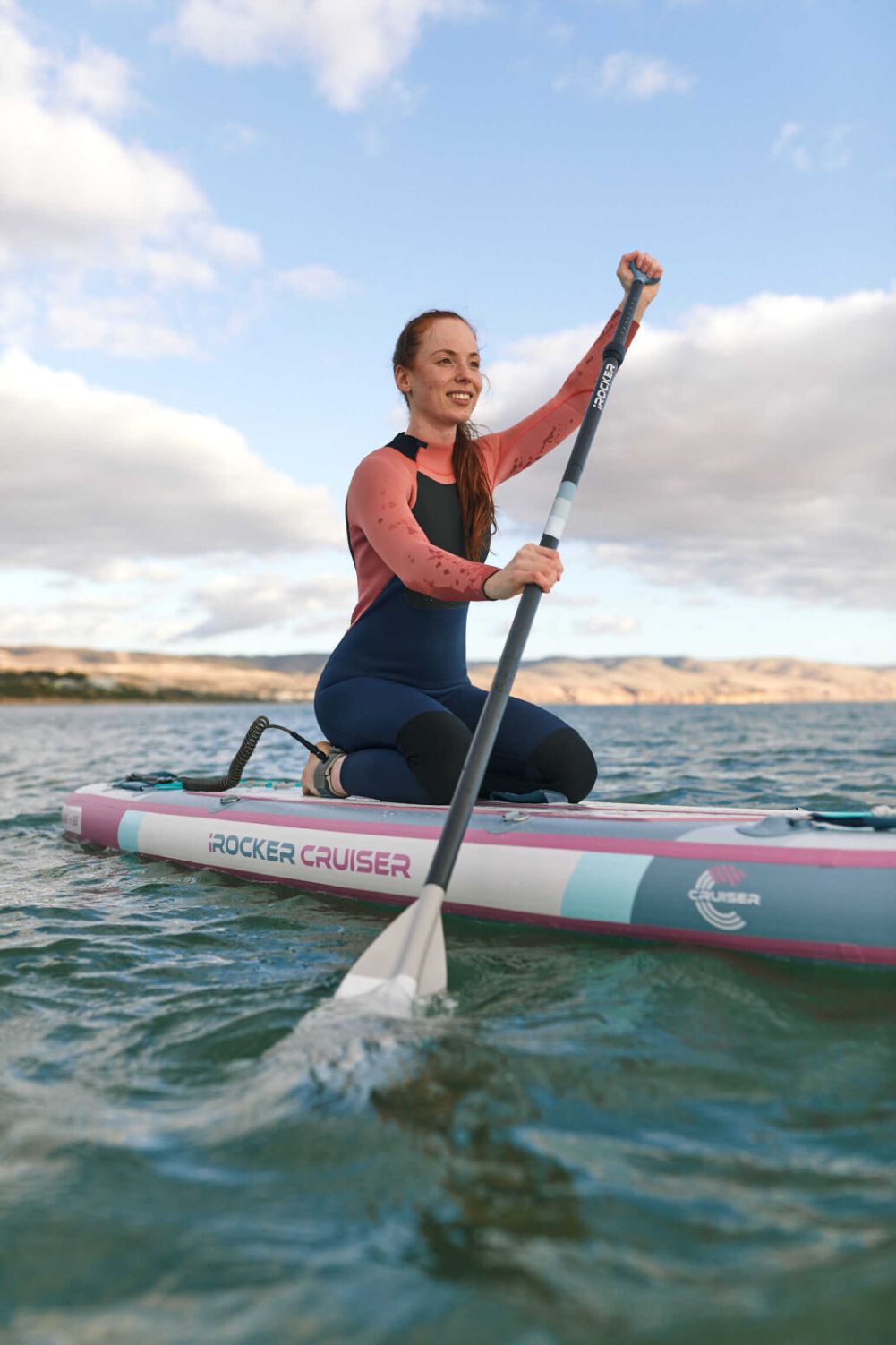Are you ready to live your best life on the water? Stand up paddle boarding and kayaking are both popular water sports that offer limitless enjoyment and discovery. But which to choose? Let’s dig in.
| FEATURE | PADDLE BOARD | KAYAK |
|---|---|---|
| Stability | Excellent stability for calm waters and good for beginners | Stable in various water conditions, including rough water |
| Size | Generally smaller and lighter than kayaks | Larger and heavier than paddle boards |
| Portability | Easy to transport, inflatable options available | Less portable, requires roof racks or trailer |
| Durability | Durable construction, even for inflatable models | Rugged, hard-shell materials provide added durability |
| Gear Storage | Limited storage, but attachments available for most boards | Ample storage in hatches and on deck |
| Fitness | Excellent full-body workout, engages core muscles | Focuses on upper body and cardio fitness |
| Price | Wide price range, generally more affordable | Wider price range, some models can be expensive |
Paddle Board vs Kayak: Which is Easier?
Both kayaking and paddle boarding offer exciting challenges, each presenting a unique learning curve.
So, is paddleboarding easy? Most novices can swiftly conquer balance and maneuvering on a stand up paddle board in just a few hours. And the longer you spend on your board, the more comfortable you’ll become. Start out on calm waters and work your way up to longer and more challenging paddle sessions, and even take on some exhilarating ocean waves.

Similarly, kayaking beginners can master paddling in a matter of hours, all while remaining comfortably seated on the water. This makes it a less physically taxing pursuit on the lower body but it can be a great upper body workout, especially if paddling hard or against a current.
What’s the Better Option?
Selecting the perfect watercraft for your on-the-water adventure is crucial, and understanding your individual preferences and needs will guide you towards the right choice.
Stand up paddle boarding delivers a distinctive experience that not only engages your core muscles for a full-body workout, but also allows you to appreciate the stunning scenery around you. In contrast, kayaking provides stability and comfort for extended journeys, making it easy to cover long distances and navigate various water conditions.
1. Fitness
SUP shines as a top workout choice with a low-impact, full-body workout that tones muscles and burns calories. It's an effective way to get in shape since it works everything from your legs to your core and upper body.
Meanwhile, kayaking also provides a solid workout, primarily focusing on your upper body. Your fitness goals determine the best fit, but for an all-around stabilizer muscle workout, SUP takes the lead.
2. Stability
When we talk about stability on the water, kayaks edge out slightly ahead due to their lower center of gravity, making them inherently more stable, especially for those just starting out.
With SUP, you're standing up, which naturally challenges your balance more. But don't let this deter you – it's precisely this standing position that attracts many to paddle boarding in the first place. It adds an element of challenge and fun that's hard to beat.
3. Getting Back On
As for reboarding after a tumble, SUPs are notably more user-friendly in this aspect. Their open and flat design allows for effortless climbing back on board. Even if you fall off, the board stays nearby, thanks to the use of a leash.
In contrast, kayaks present a bit more of a challenge. If your kayak capsizes, you first need to flip it over, which can be a daunting task, especially in deep waters. Then, getting back into the kayak requires some practice and skill, balancing yourself to avoid another capsize.
4. On-Board Storage
When comparing on-board storage, kayaks generally offer more advantages. Kayaks are equipped with designated storage spaces, ideal for longer trips or when you need to carry equipment like cameras, fishing gear, or picnic supplies. The storage areas in kayaks are designed to keep your belongings relatively dry and are easily accessible while you're on the water.
Paddle boards, on the other hand, provide a different storage dynamic. They come with limited deck space where you can secure your gear. However, managing this space is crucial as it impacts your ability to maneuver the board. Any gear on a SUP is also exposed to elements, necessitating waterproof containers for protection. While SUPs can carry a decent amount of gear, accessing it mid-paddle can be more cumbersome than with a kayak.
5. Transport and Portability
In terms of transport and portability, paddle boards often have an edge over kayaks, particularly when considering inflatable models. Inflatable SUPs are lightweight and can be easily packed into a carrying bag, making them a breeze to transport and store. This portability is a significant advantage for those with limited storage space or for adventurers who like to take their board on travels.

Kayaks, while also available in inflatable versions, tend to be bulkier and heavier, especially the hard-shell varieties. This makes them more challenging to transport and requires more storage space. Inflatable kayaks, although more portable than their hard-shell counterparts, can still be more cumbersome compared to inflatable paddle boards. Ultimately, if ease of transport and storage are high on your priority list, an inflatable SUP might be the way to go.
6. Overall Fun Factor
Moving onto the overall fun factor in the debate between paddle boards and kayaks, SUPs often take the lead.
The versatility of stand up paddle boarding is a thrilling experience for all ages, where you can paddle with kids, bring your dog along, or even engage in SUP yoga. The standing position on a SUP board offers a unique workout and is one of the most engaging ways to explore the waters. The ability to jump off for a swim and easily climb back on adds to the fun.
Kayaks, while offering a different kind of enjoyment, typically provide a more focused and traditional paddling experience. They are excellent for longer, more serene journeys and are perfect for those who enjoy a more relaxed approach to water exploration.
7. Perspective for Sightseeing
For sightseeing, paddle boards offer a distinct advantage over kayaks. The elevated standing position on a SUP provides a better vantage point, allowing you to enjoy a view of your surroundings, both above and below the water's surface. This feature is particularly beneficial for nature observation, wildlife spotting, and simply taking in the scenic beauty.
In contrast, kayaks sit lower in the water, which can limit your range of sight, especially for viewing distant landscapes or spotting wildlife. However, they still offer a close-to-water experience that many find appealing, especially when navigating through narrow waterways or exploring hidden nooks.
8. Cold Weather Paddling
In colder conditions, kayaks generally provide a more suitable option than paddle boards. The seated position in a kayak helps shield you from the wind and keeps you drier, reducing exposure to the cold. This makes kayaks a preferred choice for paddling in chilly weather or in colder water bodies.
On the other hand, SUPs can be more challenging in cold conditions due to the exposed standing position. This exposure can lead to increased cold and wind exposure. However, with the right gear and clothing, paddle boarding is still possible and enjoyable in colder climates, though it requires a higher tolerance for the cold.
9. Warm Weather Paddling
Regarding warm weather, stand up paddle boards offer a delightful experience. The advantage of SUPs in warmer conditions is their open design, allowing you to easily cool off. Feeling the water splash on your feet and the ability to jump in for a swim enhances the paddling experience. Additionally, the standing position on a SUP exposes you to refreshing breezes, making it a joy on hot days.

Kayaks, while less open compared to SUPs, still offer a pleasant experience in warm weather. They provide a more sheltered paddling experience, which can be beneficial for sun protection but might limit the ease of cooling off.
10. Paddling Long Distances
For long-distance paddling, kayaks are often the better choice. The seated position in a kayak makes it easier to cover longer distances, offering more stability and less physical strain compared to standing on a SUP. Kayaks are also generally faster and more efficient in the water, making them ideal for extended journeys.
On the other hand, while SUPs can be used for long distances, they demand more physical effort, particularly in maintaining balance and posture over extended periods. This can be more tiring, especially for less experienced paddlers.
11. Affordability
Both paddle boards and kayaks span a wide price range from entry-level to high-end models. The cost ultimately depends on the specific features, brand, and material quality you're looking for.
12. Durability
Kayaks often have a slight edge, especially in rougher conditions for their durability. They are typically built to withstand impacts and are less susceptible to damage from rocks and other obstacles. SUPs, while also durable, have vulnerable parts like fins that can be damaged in shallow or rocky waters. However, the durability of both kayaks and SUPs greatly depends on their construction materials and design.

13. Maneuverability
Generally, shorter kayaks and SUPs are more agile and easier to turn, ideal for navigating tight spaces. Longer models provide better tracking and speed but are less maneuverable.
The choice between a kayak and a SUP in terms of maneuverability will depend on the specific water conditions and personal paddling preferences.
14. Speed
When speed is the priority, kayaks generally outpace paddle boards. Thanks to their streamlined shape and lower center of gravity, kayaks cut through the water more efficiently. This design, coupled with a double-bladed paddle, allows for quicker and more powerful strokes, making kayaks faster over distances. Conversely, paddle boards, while offering their own set of advantages, typically lag in speed due to their wider shape and single-blade paddles.
15. Comfort
Comfort levels differ markedly between kayaks and SUPs. Kayaks, with their seated paddling position, provide more support and comfort, especially over longer distances or during extended periods of paddling.
In contrast, paddle boards require standing, kneeling, or sitting directly on the board, which can be more physically demanding and less comfortable for some individuals, particularly on longer excursions.
16. Paddling in Windy Conditions
In windy conditions, kayaks offer a more manageable and less challenging experience. Their low profile and seated position reduce wind resistance, making them easier to control and navigate when the wind picks up.

Paddle boards, with their higher stance and larger surface area, can be more difficult to handle in windy conditions, as they are more affected by wind and waves. However, knowing the best wind conditions for paddle boarding can greatly enhance the experience. Paddlers on SUPs may need to adopt a kneeling position to reduce wind resistance and maintain control in less than ideal conditions.
17. Freedom of Movement
Paddle boards excel in offering freedom of movement. On a SUP you can sit, stand, kneel, or even lie down, giving you a range of options to enjoy your time on the water, which is ideal for those who love to move around, stretch, or engage in activities like yoga.
In contrast, kayaks, with their fixed seating positions, limit movement to primarily paddling and shifting within the confines of the cockpit. While this is ideal for stability and long-distance travel, it doesn't match the versatility of movement that a SUP provides.
18. Fishing
Fishing from a kayak has been popular for a long time, and for good reason. Kayaks offer stability, ample storage for gear, and the ability to navigate various water conditions easily. However, fishing from a paddle board is gaining popularity.
SUPs offer an elevated view for spotting fish and greater mobility to cast lines. The choice between a kayak and a SUP for fishing largely depends on personal preference, the fishing environment, and the type of fishing experience you're looking for.
19. Yoga
When it comes to yoga, paddle boards are the clear winner. The flat, stable surface of a SUP makes it an ideal platform for yoga on the water, adding a layer of balance and tranquility to your practice. This isn't feasible in a kayak, which is designed for seated paddling.
SUP yoga challenges your core, balance, and focus, enhancing the overall yoga experience by integrating the soothing elements of being on the water.
20. Sun Protection
When sun protection comes into play, kayaks generally offer more coverage than paddle boards. When you're seated in a kayak, a significant part of your body is shielded from direct sunlight, particularly the lower body and, to some extent, the torso.
In contrast, stand up paddle boarding exposes almost your entire body to the sun, as you're standing upright on the board. This exposure makes it crucial to wear protective clothing and use sunscreen while on a SUP, especially during peak sun hours.
21. Accessibility
Considering accessibility for beginners, stand up paddle boards often have an edge over kayaks. SUPs are renowned for their stability and ease of use, making them more accessible for first-timers. The process of getting onto a paddle board is straightforward, and the simplicity of standing or kneeling on it allows new paddlers to quickly gain confidence.
Kayaks, while also beginner-friendly, present a slightly steeper learning curve. The skills required for entering, exiting, and maneuvering a kayak, as well as dealing with a potential capsize, can be more challenging for novices. Additionally, the easy reboarding of a SUP in water makes it a more suitable option for beginners concerned about falling off and getting back on.
Paddle Board vs Kayak: Finding the Right Equipment
Choosing between a paddle board vs kayak depends on your preferred physical challenge, water type, and recreational interests. Consider these factors when selecting the right equipment:

- Purpose: Determine your desired activities such as touring, fishing, or racing. Kayaks are suitable for longer trips, while paddle boards excel in leisurely exploration and can be used as fishing platforms.
- Skill Level: For beginners, choose a sturdy, easy-to-use option. Inflatable paddle boards suit new users, while sit-on-top kayaks are ideal for those with less paddling experience or those who have difficulties with balance.
- Water Conditions: Consider the type of water you'll be navigating. Paddle boards perform well in calm waters like lakes and bays, while kayaks are more versatile and can handle various conditions, including choppy seas and even rapids.
- Storage and Transport: If storage and transport are concerns, consider an inflatable paddle board or an inflatable kayak, as they are more compact and easier to carry and store.
- Budget: Paddle boards and kayaks come in a wide range of prices. Determine your budget and compare the available options within your price range.
How to Convert Your SUP Into a Kayak
Love the idea of both paddle boarding and kayaking? Why not transform your stand-up paddle board (SUP) into a kayak for the best of both worlds? Here's how to make the switch:
- Ensure compatibility: Your SUP must have attachment points for a kayak seat and adequate space for comfortable seating.
- Get a kayak seat: Purchase a paddle board seat specifically designed for SUP-to-kayak conversion. These seats attach using straps and D-rings or clips.
- Find a kayak paddle or converter: You'll need a double-bladed kayak paddle or a converter kit to transform your single-bladed SUP paddle into a double-bladed kayak paddle.

With the necessary kayak attachments in hand, attach the seat to your SUP, adjust the straps for a secure and comfortable fit, and swap out your paddle. Voilà! You've got yourself a hybrid watercraft for a versatile experience.
Paddle boards vs kayaks each boasts distinctive perks and quirks. To choose the ideal watercraft, weigh factors such as skill level, water conditions, intended use, storage, transport, and budget.
Set out on an unforgettable adventure with the perfect watercraft from iROCKER's extensive collection. Seize the day and experience the thrill of the open water. Happy paddling!
FAQs
Can a SUP keep up with a Kayak?
It depends on the conditions and the skill of the paddler. In calm water and over short distances, a skilled paddler on a SUP can keep up with a kayak. However, over longer distances or in rougher water, a kayak is generally faster and more efficient.
Is SUP with a kayak seat slower than a real kayak?
Yes, a SUP with a kayak seat is typically slower than a real kayak. The wider and less streamlined shape of a SUP increases drag, making it less efficient and slower compared to the streamlined design of a kayak.





















